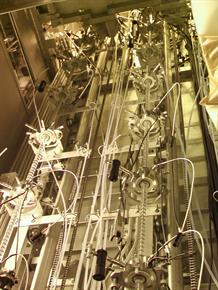Using today's available resources in the current reactor fleet
France currently imports 8,000 tonnes of natural uranium every year, which is used to manufacture 1,000 tonnes of enriched uranium to power the nuclear power plants. The remaining 7,000 tonnes of depleted uranium is stored. Its stockpiles have reached in excess of 270,000 tonnes, which cannot be exploited in the current pressurised water reactor (PWR) fleet.
Furthermore, France has chosen to treat the spent fuel generated by its nuclear power plants. Recyclable materials from this spent fuel (i.e. uranium and plutonium) can be re-employed to make a nuclear fuel called MOX, which stands for mixed uranium and plutonium oxide. Yet this kind of fuel can only be used efficiently once in the reactors currently in operation. Spent MOX fuel is therefore stored temporarily in spent fuel pools.
Relevance of fast neutrons
Fast reactors make it possible to:
- Burn all types of uranium (including depleted uranium resulting from enrichment processes and reprocessed uranium extracted from spent fuels)
- Recycle plutonium multiple times
- Reduce the radiotoxicity, lifetime and volume of ultimate waste.

High-level pulse extraction column in the Atalante facility at Marcoule used to perform multiple recycling experiments on uranium and plutonium. © CEA
"There are multiple advantages", said Bernard Boullis, the programme director for the back-end of the fuel cycle at the CEA Nuclear Energy Division at Saclay. "Fast reactors not only burn plutonium which means large stockpiles do not accumulate, but they can also use practically all of uranium-238 contained in the fuel." Around 99% of uranium-238 would be expendable in fast reactors.
For this reason, fast reactors will not call for enriching uranium prior to its use, which is a valuable asset with respect to the issue of nuclear proliferation. As uranium-238 is more abundant on earth than uranium-235, not to mention the fact that France has large stockpiles of it, the country's electricity production could be secured for several thousand years.
Even so, plutonium is needed to start up the first reactors of this kind. This plutonium could be recovered from spent MOX fuels that are currently stored in pools at La Hague reprocessing plant, with volumes representing enough material to already commission ten power plants.
Fast reactors could also be used to get rid of certain problematic waste produced by the nuclear industry. These would be capable of burning minor actinides through a process called transmutation. The processes used to isolate these minor actinides in spent fuel - prior to being burned - are also well known: they are currently being developed at the CEA Marcoule centre.
Therefore, the fast reactor technology is a key component of a closed fuel cycle strategy making it possible to efficiently manage recyclable materials in spent fuel, firstly from a fleet of thermal neutron reactors and then subsequently from a homogeneous fleet of fast reactors.